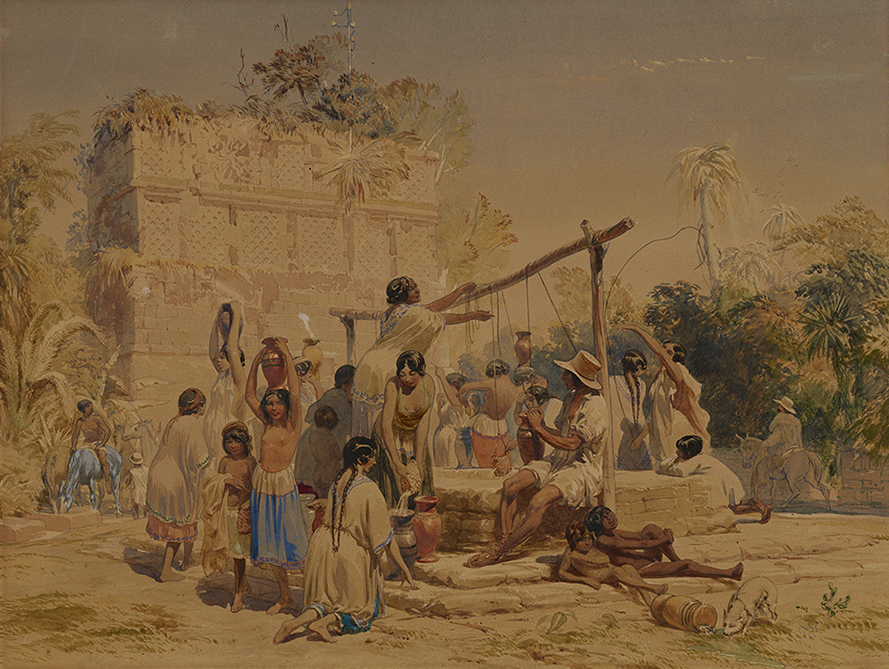Frederick Catherwood
Well and Building at Sabachtsché
1840
Frederick Catherwood
Well and Building at Sabachtsché, 1840
Watercolor on paper, 11 ½ x 15 ¼ inches (29.2 x 38.7 cm)
Jay I. Kislak Collection of the Early Americas, Exploration and Navigation, MDC PC 2018.1.20
The English artist and archaeologist Frederick Catherwood (1799–1854) accompanied the American writer and explorer John Lloyd Stephens (1805–52) on expeditions to Mesoamerica between 1839 and 1842. Catherwood produced copious drawings and watercolors that served as the basis for the engraved illustrations in Stephens’s pioneering accounts of the monumental Maya ruins, Incidents of Travel in Central America, Chiapas and Yucatán (1841) and Incidents of Travel in Yucatán (1843). Stephens and Catherwood’s books introduced readers not only to many unpublished Maya sites but also to the current inhabitants of the area, the contemporary Maya people. They convincingly demonstrated that the local indigenous peoples were the descendants of the great builders of the past, a view not widely shared at the time.
In Chapter II, Volume II, of Incidents of Travel in Yucatan, Stephens recounts their visit to a settlement called Sabactsché or Sabachshé:
At half past five we reached the rancho of Sabachshé, lying on the camino real from Ticul to Bolonchen, and inhabited entirely by Indians. . . . [T]his rancho was distinguished by a well, the sight of which was more grateful to us than that of the best hotel to the traveller in a civilized country. . . . [I]t presented a curious and lively spectacle. A group of Indian women was around it. It had no rope or fixtures of any kind for raising water, but across the mouth was a round beam laid upon two posts, over which the women were letting down and hoisting up little bark buckets. Every woman brought with her and carried away her own bucket and rope, the latter coiled up and laid on the top of her head, with the end hanging down behind, and the coil forming a sort of headdress.
The next morning, they visited the nearby ruins:
Crossing the fence of the last hut, we entered a thick growth of trees. As if instinctively, every Indian drew his machete, and in a few minutes they cut a path to the foot of a small building, not rich in ornament, but tasteful, having some shades of difference from any we had seen, overgrown by trees, and beautifully picturesque. . . . In half an hour space enough was cleared for Mr. Catherwood to set up his camera lucida. The same alertness was shown in preparing a place for him to stand in, and half a dozen stood ready to hold an umbrella for his protection against the sun. . . .
[The building’s] design is tasteful and even elegant, and when perfect it must have presented a fine appearance. It has a single doorway, opening into a chamber twenty-five feet long by ten wide. Above the door is a portion of plain masonry, and over this a cornice supporting twelve small pilasters, having between them the diamond ornament, then a massive cornice, with pilasters and diamond work, surmounted by another cornice, making in all four cornices; an arrangement we had not previously met with.
In 1844, Catherwood published Views of Ancient Monuments in Central America, Chiapas and Yucatan, a portfolio of 25 hand-colored lithographs with a dedication to Stephens. Catherwood’s watercolor in the Kislak collection, Well and Building at Sabachtsché, was translated quite directly as Plate XVIII in the portfolio. In the illustrations for Stephens’s books, Catherwood strove for documentary accuracy in his views of ancient Maya structures. Here, however, he favors a more picturesque approach, giving us a lively scene of local people around the well, while the impressive overgrown façade serves as a backdrop. In reality, as we know from Stephens’s account, the two things did not stand in such proximity to each other. While the women drawing water from the well in woven baskets correspond with the written description, the half-nakedness of several of the young women in the image seems more designed to evoke classical tropes of Western art, as well as to provide a slightly titillating exoticism for mid-nineteenth-century English-speaking audiences. And, of course, the artist meant us to mentally compare the cosmopolitan magnificence of the Maya past to the rural simplicity of the present-day, and thereby romantically contemplate the glories of the past, the fleetingness of time, and, more tacitly, the superiority of modern Western civilization.
Photography was introduced in 1839, but when Stephens and Catherwood explored the Maya ruins, it had not yet become widely adopted. Catherwood used the camera lucida, an optical device with a prism that allowed one to trace a scene onto paper with great fidelity, making his renderings of ancient edifices a valuable resource for generations to come. In July 1842, however, many of Catherwood’s original paintings and drawings, along with a number of Maya artifacts, perished when the building in New York in which they were exhibited caught fire. The present watercolor, then, represents a rare survivor of this early phase in the West’s understanding of the Maya people.

